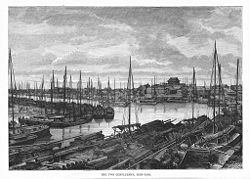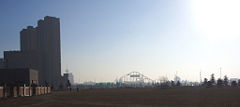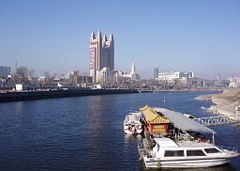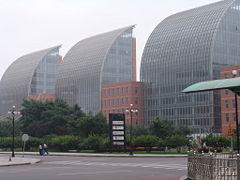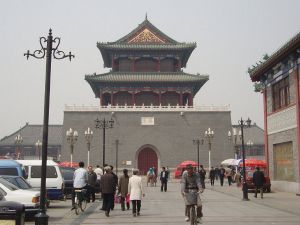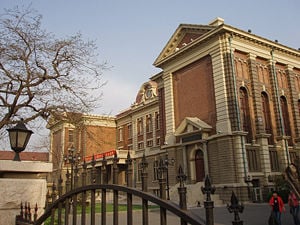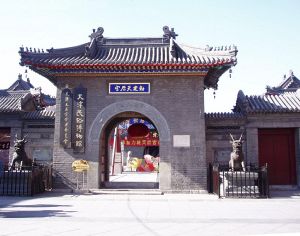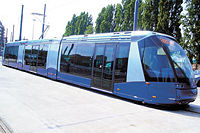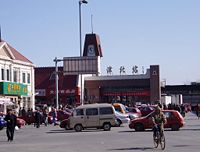Tianjin
| Abbreviation: 津 (pinyin: Jīn) | |
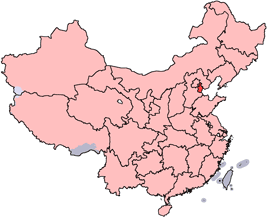
| |
| Origin of name | 天 tiān - heaven 津 jīn - river ford "emperor's ford" |
| Administration type | Municipality |
| CPC Tianjin Committee Secretary | Zhang Gaoli 张高丽 |
| Mayor | Dai Xianglong 戴相龙 |
| Area | 11,920 km² (30th) |
| Population (2004) - Metropolitan area - Density |
10,240,000 (27th) approx. 5 million 859/km² (3rd) |
| Elevation | 10 m / 33 ft |
| GDP (2006) - per capita |
CNY 433.8 billion (21st, 6th in city rank) CNY 40,961 (3rd) |
| HDI (2005) | 0.855 (3rd) — high |
| Major nationalities (2000) | Han - 97% Hui - 2% Manchu - 0.6% |
| City flower | Chinese rose (Rosa chinensis) |
| County-level divisions | 18 |
| Township-level divisions (December 31, 2004) |
240 |
| Postal code | 300000 - 301900 |
| Area code | 22 |
| Licence plate prefixes | 津A, B, C, D |
| 津E (taxis) | |
| ISO 3166-2 | CN-12 |
| Official website: www.tj.gov.cn (Simplified Chinese) | |
Tianjin ▶ (Chinese: 天津; pinyin: Tiānjīn; Postal map spelling: Tientsin) is one of four municipalities of the [[People's Republic of China] that are administered directly under the central government and have provincial-level status. It is located in the north-eastern part of the country along the eastern coast. Tianjin borders Hebei to its south and northeast, while Beijing municipality lies to its north and the Bohai Bay in the Pacific Ocean lies to the east.
The urban area of Tianjin is located along the Haihe River, and is the third largest in China, after Shanghai and Beijing. Its ports, located some distance away from the urban center, are located on the Bohai Gulf in the Pacific Ocean.
History
The land that Tianjin lies upon today was created through a process of sedimentation of various rivers entering the sea at the Bohai Bay(渤海湾), including the Yellow River, which entered the sea in this area at one point.
Tianjin began its development into a major port and trading center upon the opening of the Grand Canal of China during the Sui Dynasty. Until 1404, Tianjin was called "Zhigu" (直沽), or the "Straight Port", but in that year, the Emperor Yongle (永乐) renamed the city "Tianjin", which literally means "Heaven Ford". This name refers to the fact that the emperor (son of heaven) forded the river while on a campaign to wrest the throne from his nephew.
In 1725, Tianjin was promoted to become a prefecture under the authority of the Qing Dynasty. A Tianjin county was established under the prefecture of the same name in 1731 by the Qing.
In 1856 Chinese soldiers boarded The Arrow, a Chinese-owned ship registered in Hong Kong flying the British flag and suspected of piracy, smuggling and of being engaged in the opium trade. They captured 12 men and imprisoned them. In response the British and French sent gunboats under the command of Admiral Sir Michael Seymour to capture the Taku forts (大沽炮台)near Tianjin in May 1858. At the end of the first part of the Second Opium War in June of the same year, the Treaties of Tianjin were signed, which opened Tianjin to foreign trade. The treaties were ratified by the Emperor of China in 1860, and Tianjin was formally opened to the outside world. Between 1895 and 1900 Britain and France were joined by the empires of Japan, Germany and Russia, and even by countries without other Chinese concessions such as Austria-Hungary, Italy and Belgium, in establishing self-contained concessions in Tianjin, each with its own prisons, schools, barracks and hospitals. For a map, see [1]
The presence of foreign influence in Tianjin was not always peaceful; one of the most serious violent incidents to take place was the Tianjin Church Incident (天津教案). In June 1870, Wanghailou Church (T: 望海樓教堂 / S: 望海楼教堂) in Tianjin, built by French missionaries one year earlier, was implicated in the kidnapping, death by neglect, and improper burial of Chinese children. It was said in the Chinese population that nuns were making preserves of children's eyes (it seems that the confusion came from jars of pickled small onions seen in the kitchen). On June 21, the magistrate of Tianjin County initiated a showdown at the church that developed into violent clashes between the church's Christian supporters and non-Christian Tianjin residents. The furious protestors eventually burned down Wanghailou Church and the nearby French consulate. After the incident, France and six other Western nations complained to the Qing government, which was forced to pay compensation for the incident.
In June 1900, the Boxers(义和团) were able to seize control of much of Tianjin. On June 26 belligerent European forces heading towards Beijing (北京)were stopped by Boxers at nearby Langfang(廊坊), and were defeated and forced to turn back to Tianjin. The foreign concessions also came under siege for several weeks.
In July of 1900, the Eight Nation United Army attacked and occupied Tianjin. They soon established the Tianjin Provisional Government, comprised of representatives from each of the occupying forces (Russian, British, Japanese, German, French, American, Austro-Hungarian, and Italian). Tianjin was governed by this council until August 15, 1902 when the city was returned to Qing control. The well-known Qing general, Yuan Shikai(袁世凯), headed efforts to remake Tianjin into a modern city.
Tianjin was established as a municipality of China(直辖市) in 1927.
On July 30, 1937, Tianjin fell to Japan, as part of the Second Sino-Japanese War, but not entirely occupied, respecting non-foe foreign concessions. During the occupation Tianjin was ruled by the North China Executive Committee, a puppet state based in Beijing. Japanese occupation lasted until August 15, 1945, the surrender of Japan marking the end of World War II.
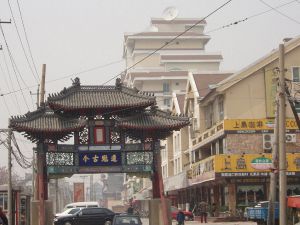
After 1945, Tianjin became base to American forces. In December 1946, the rape of a Beiping (北平)(now Beijing(北京)) female university student by an American soldier, together with a series of rapes that had previously occurred in Tianjin, sparked protests in Tianjin that culminated in a demonstration on January 1, 1947 involving thousands of students. American troops pulled out of Tianjin in June 1947.
Communist forces took Tianjin on January 15, 1949, following a 29-hour long battle. After communist takeover, Tianjin remained a municipality of China(直辖市), except between 1958 and 1967, when it was reduced to part and capital of Hebei province (河北省省会). The Tangshan earthquake(唐山大地震) of 1976 killed 23,938 people in Tianjin and did heavy damage.
After China began to open up in the late 1970s, Tianjin has seen rapid development, though it is now lagging behind other important cities like Shanghai(上海), Beijing(北京), and Guangzhou(广州). The city's current mayor is Dai Xianglong (戴相龙).
Geography
Tianjin is at the northern end of the Grand Canal of China(大运河), which connects with the Huang He (黄河)and Yangtze (长江)rivers.
Tianjin Municipality is generally flat, and swampy near the coast, but hilly in the far north, where the Yanshan Mountains (燕山)pass through the tip of northern Tianjin. The highest point in Tianjin is Jiushanding Peak on the northern border with Hebei, at an altitude of 1078 m.
The Hai He River(海河) forms within Tianjin Municipality at the confluence of the Ziya River(子牙河), Daqing River(大清河), Yongding River(永定河), North Grand Canal, and South Grand Canal; and enters the Pacific Ocean at Tianjin Municipality as well, in Dagu District. Major reservoirs include the Beidagang Reservoir in the extreme south (in Dagang District) and the Yuqiao Reservoir in the extreme north (in Ji County).
The urban area of Tianjin is found in the south-central part of the Municipality. In addition to the main urban area of Tianjin proper, the coast along the Bohai is lined with a series of port towns, including Tanggu (塘沽)and Hangu(汉沽).
Tianjin's climate is a monsoon-influenced humid continental climate (Koppen climate classification Dwa) characterized by hot, humid summers, due to the monsoon, and dry, cold winters, due to the Siberian anticyclone. Average highs in January and July are 36 degrees F (2C) and 87 degrees F (31C) respectively). Spring is windy but dry, and most of the precipitation takes place in July and August. Tianjin also experiences occasional spring sandstorms which blow in from the Gobi Desert and may last for several days.
Administrative divisions
Tianjin is divided into 18 county-level divisions, including 15 districts and 3 counties. Six of the districts govern the urban area of Tianjin:
- Heping District (Simplified Chinese: 和平区; Hanyu Pinyin: Hépíng Qū)
- Hexi District (河西区 Héxī Qū)
- Hebei District (河北区 Héběi Qū)
- Nankai District (南开区 Nánkāi Qū)
- Hedong District (河东区 Hédōng Qū)
- Hongqiao District (红桥区 Hōngqiáo Qū)
Three of the districts govern towns and harbours along the seacoast:
- Tanggu District (塘沽区 Tánggū Qū)
- Hangu District (汉沽区 Hàngū Qū)
- Dagang District (大港区 Dàgǎng Qū)
- These districts collectively make up the economic development zone of Binhai.
Four of the districts govern satellite towns and rural areas close to the urban center:
- Jinnan District (津南区 Jīnnán Qū)
- Dongli District (东丽区 Dōnglì Qū)
- Xiqing District (西青区 Xīqīng Qū)
- Beichen District (北辰区 Běichén Qū)
Two of the districts as well as the three counties govern towns and rural areas further away from the urban center:
- Baodi District (宝坻区 Bǎodǐ Qū) — Baodi County before 2001
- Wuqing District (武清区 Wǔqīng Qū) — Wuqing County before 2000
- Ji County (蓟县 Jì Xiàn)
- Jinghai County (静海县 Jìnghǎi Xiàn) [2] (Chinese)
- Ninghe County (宁河县 Nínghé Xiàn)
In addition, the Tianjin Economic and Technological Development Area (TEDA) is not a formal level of administration, but nevertheless enjoys rights similar to a regular district.
These districts and counties are further subdivided, as of December 31, 2004, into 240 township-level divisions, including 120 towns, 18 townships, 2 ethnic townships and 100 subdistricts.
Economy
The nominal GDP for Tianjin was 433.8 billion yuan (US$54.4 billion) in 2006, a year-on-year increase of 14.4%. [3]
In 2006, per capita GDP was 40,961 yuan. The manufacturing sector was the largest (53.2%) and fastest-growing (19.8%) sector of Tianjin's economy. Urban disposable income per capita was 14,283 yuan, a real increase of 13% from the previous year. Rural pure income per capita was 7,942 yuan, a real increase of 13% from the previous year.
Farmland takes up about 40% of Tianjin Municipality's total area. Wheat, rice, and maize are the most important crops. Fishing is important along the coast. Tianjin is also an important industrial base. Major industries include petrochemical industries, textiles, car manufacturing, mechanical industries, and metalworking.
Tianjin Municipality also has deposits of about 1 billion tonnes of petroleum, with Dagang District containing important oilfields. Salt production is also important, with Changlu Yanqu being one of China's most important salt production areas. Geothermal energy is another resource of Tianjin. Deposits of manganese and boron under Tianjin were the first to be found in China.
EADS Airbus will be opening an assembly plant for its A320 series airliners, to be operational in 2009. AVIC I and AVIC II will be EADS' local partners for the site, to which subassemblies will be sent from plants around the world.[1]
Demographics
At the end of 2004, the population of Tianjin Municipality was 10.24 million, of which 9.33 million were holders of Tianjin hukou (permanent residence). Among Tianjin permanent residents, 5.56 million were urban, and 3.76 million were rural. [4]
The majority of Tianjin residents are Han Chinese. Minorities include Hui, Koreans, Manchus, and Mongols.
| Ethnic groups in Tianjin, 2000 census | ||
|---|---|---|
| Nationality | Population | Percentage |
| Han | 9,581,775 | 97.29% |
| Hui | 172,357 | 1.75% |
| Manchu | 56,548 | 0.57% |
| Mongol | 11,331 | 0.12% |
| Korean | 11,041 | 0.11% |
| Zhuang | 4055 | 0.041% |
| Tujia | 3677 | 0.037% |
Excludes members of the People's Liberation Army in active service.
Source: Department of Population, Social, Science and Technology Statistics of the National Bureau of Statistics of China (国家统计局人口和社会科技统计司) and Department of Economic Development of the State Ethnic Affairs Commission of China (国家民族事务委员会经济发展司), eds. Tabulation on Nationalities of 2000 Population Census of China (《2000年人口普查中国民族人口资料》). 2 vols. Beijing: Nationalities Publishing House (民族出版社), 2003. (ISBN )
Education
Colleges and universities
Under the national Media:Ministry of Education:
- Tianjin University (天津大学) (founded 1895, first university in China)
- Nankai University (南开大学) (founded 1919)
Under the national Civil Aviation Authority:
- Civil Aviation University of China (中国民航大学)
Under the municipal government:
- Hebei University of Technology (河北工业大学) (founded 1903)
- Tianjin Academy of Fine Arts (天津美术学院)
- Tianjin Agricultural College (天津农学院)
- Tianjin Conservatory of Music (天津音乐学院)
- Tianjin Foreign Studies University (天津外国语大学)
- Tianjin Institute of Physical Education (天津体育学院)
- Tianjin Medical University (天津医科大学)
- Tianjin Normal University (天津师范大学)
- Tianjin Polytechnic University (天津工业大学)
- Tianjin University of Commerce China (天津商业大学)
- Tianjin University of Finance & Economics (天津财经大学)
- Tianjin University of Science & Technology (天津科技大学)
- Tianjin University of Technology (天津理工大学)
- Tianjin University of Technology and Education (天津职业技术师范学院)
- Tianjin University of Traditional Chinese Medicine (天津中医药大学)
- Tianjin Urban Construction Institute (天津城市建设学院)
Foreign institutions:
- The Florida International University Tianjin Center, opened in 2006 as a cooperative venture between the municipal government and the Miami-based university.
Note: Institutions without full-time bachelor programs are not listed.
Culture
People from urban Tianjin speak Tianjin dialect, which comes under the Mandarin subdivision of spoken Chinese. Despite its proximity to Beijing, Tianjin dialect sounds quite different from Beijing dialect, which provides the basis for Putonghua, official spoken language of the People's Republic of China.
Tianjin cuisine places a heavy focus on seafood, due to Tianjin's proximity to the sea. Prominent menus include the Eight Great Bowls (八大碗), a combination of eight mainly meat dishes. It can be further classified into several varieties, including the rough (粗), smooth (S: 细 / T: 細), and high (高). The Four Great Stews (四大扒) refers actually to a very large number of stews, including chicken, duck, seafood, beef, and mutton.
Tianjin also has several famous snack items. Goubuli (狗不理包子) is a traditional brand of baozi(包子) (steamed buns with filling) that is famous throughout China. Guifaxiang (S: 桂发祥麻花 / T: 桂發祥麻花) is a traditional brand of mahua (麻花)(twisted dough sticks). Erduoyan (耳朵眼炸糕) is a traditional brand of fried rice cakes.
Tianjin is a respected home base of Beijing opera, one of the most prestigious forms of Chinese opera.
Ma Sanli (马三立)(1914 - 2003), an ethnic Hui and longtime resident of Tianjin, is paramountly respected in China for his xiangsheng(相声), a hugely popular form of Chinese entertainment similar to stand-up comedy. Ma Sanli delivered some of his xiangsheng in the Tianjin dialect(天津话).
Yangliuqing (Green Willows), a town about 15 km west of Tianjin's urban area and the seat of Tianjin's Xiqing District, is famous for its popular Chinese New Year-themed, traditional-style, colourful wash paintings (杨柳青年画). Tianjin is also famous for Zhang's clay figurines (S: 泥人张 / T: 泥人張) which are a type of colourful figurine depicting a variety of vivid characters, and Tianjin's Wei's kites (S: 风筝魏 / T: 風箏魏), which can be folded to a fraction of their full sizes, are noted for portability.
Tourism
Sights within the Tianjin urban area include:
- Luzutang (Boxer Rebellion Museum)
- Guwan Shichang 古玩市场 (Antique Market)
- Guwenhua Jie 古文化街 (Ancient Culture Street)
- Wen Miao 文庙 (Confucious Temple)
- Shuishang Gongyuan 水上公园 (Water Park)
- TV Tower (天津电视塔)
- Shijia Dayuan 杨柳青:石家大院 (Shi Family Residence)
- Temple of Great Compassion 大悲禅院 (Dabeiyuan)
- Tianhougong(天后宫)
- Wanghailou Church, site of the 1870 Tianjin Massacre 望海楼教堂
- Xikai Church 西开天主教堂
- Zhou Enlai Memorial Hall 周恩来纪念馆
Sights outside the Tianjin urban area, but within the municipality, include:
- Fort Dagukou, Qing Dynasty-era cannon battlement 大沽口
- Huangyaguan Great Wall 黄崖关
- Mount Panshan盘山:京东第一山
Transportation
Metro
The Tianjin Metro is currently under heavy expansion from 3 lines to 9 lines. 3 lines are currently operating both in the city and the Binhai New Area.
Rail
There are several railway stations in the city, Tianjin Railway Station being the principal one. It was built in 1888, initially, the station was located at Wangdaozhuang (S: 旺道庄 / T: 旺道莊). The station was later moved to Laolongtou (S: 老龙头 / T: 老龍頭) on the banks of the Hai He River in 1892, so the station was renamed Laolongtou Railway Station. The station was rebuilt from scatch in 1988. The rebuilding work began on April 15, 1987 and was finished on October 1, 1988. The Tianjin Railway Station is also locally called the 'East Station', due to its geographical position.
Tianjin West Railway Station and Tianjin North Railway Station are also major railway stations in Tianjin. There is also Tanggu Railway Station is located in the important port area of Tanggu District, and TEDA Railway Station located in TEDA, to the north of Tanggu. There are several other railway stations in the city.
Construction on a Beijing-Tianjin high-speed rail began on July 4, 2005, and is scheduled to be completed in 2007.
The following rail lines go through Tianjin:
- Jingshan Railway, from Beijing to Shanhai Pass
- Jinpu Railway, from Tianjin to Pukou District, Nanjing
- Jinji Railway, from Tianjin urban area to Ji County, Tianjin
- Jinba Railway, from Tianjin to Bazhou, Hebei
Roads and expressways
Some spots in Tianjin, including roads and bridges, have names from Dr. Sun Yat-Sen's Three Principles of the People (for example, Minquan Gate on Zhonghuan Road). Names harkening back to the era of the Republic of China on the mainland also appear (e.g. Beiyang Road). Many roads in Tianjin are named after a Chinese province or city. Also, Tianjin is unlike Beijing, in that very few roads run parallel to the major four compass directions.
Tianjin has three ring roads. Unlike Beijing, the Inner and Middle Ring Roads are not closed, traffic-controlled roadways and some often have traffic light intersections. The Outer Ring Road is the closest thing to a highway-level ring road, although traffic is often chaotic and sometimes more than chaotic.
Tianjin's roads often finish in dao (道 avenue), xian (S: 线 / T: 線) line, more used for highways and through routes) and lu (路 road). Jie (街 street) is rare. As Tianjin's roads are rarely in a cardinal compass direction, jing (S: 经 / T: 經) roads and wei (S: 纬 / T: 緯) roads often appear, which attempt to run more directly north-south and east-west, respectively.
The following seven expressways of China run in or through Tianjin:
- Jingjintang Expressway, from Beijing, through Tianjin's urban area, to Tanggu District / TEDA
- Jinghu Expressway, from Jinjing Gonglu Bridge to Shanghai (together with Jingjintang Expressway, this is the expressway from Beijing to Shanghai)
- Jingshen Expressway, through Baodi District on its way from Beijing to Shenyang
- Tangjin Expressway, from Tanggu District, Tianjin, to Tangshan, Hebei — known in Tianjin as the Jintang Expressway
- Baojin Expressway, from Beichen District, Tianjin, to Baoding, Hebei — known in Tianjin as the Jinbao Expressway
- Jinbin Expressway, from Zhangguizhuang Bridge to Hujiayuan Bridge, both within Tianjin
- Jinji Expressway, from central Tianjin to Jixian County
The following six China National Highways pass through Tianjin:
- China National Highway 102, through Ji County, Tianjin on its way from Beijing to Harbin
- China National Highway 103, from Beijing, through Tianjin's urban area, to Tanggu District
- China National Highway 104, from Beijing, through Tianjin Municipality, to Fuzhou
- China National Highway 105, from Beijing, through Tianjin Municipality, to Macau
- China National Highway 112, circular highway around Beijing, passes through Tianjin Municipality
- China National Highway 205, from Shanhaiguan, Hebei, through Tianjin Municipality, to Guangzhou
The expressways are sometimes closed due to dense fog particularly in the Autumn and Spring.
Template:Roads and Expressways of Tianjin
Air
Tianjin Binhai International Airport (ZBTJ) is located to the east of the urban area, in Dongli District.
Public transit
The Tianjin tram network was awarded to a Belgian company in 1904 and opened in 1906. It was the first city-wide tramway system in China. There were 402 bus lines in the city as of 2004. [5](Chinese)
Construction work on the Tianjin Metro started on July 4, 1970. It was the second metro to be built in China and commenced service in 1984. The total length of track is 7.4 kilometers. The metro service was suspended on October 9, 2001 and is currently being rebuilt. This new metro will be called "Tianjin Metro Line 1". It is scheduled to be finished in the later half of 2005. The track will be extended to 26.188 kilometers and there will be a total of 22 stations. Previously, there were 8 stations. Several new metro lines are planned. Construction work on Line 2 and Line 3 will begin in late 2004.
There is also a light railway line in the city, the Binhai Mass Transit line. The line runs between downtown Tianjin and TEDA (Tianjin Economic Development Area) in the seaside region. The eastern part of the line began service on March 28, 2004. The western part of the line is scheduled to be completed in 2006.
Media
Tianjin People's Broadcasting Station is the major radio station in Tianjin. Broadcasting in nine channels, it serves most of North China, part of East and Northeast China, reaching an audience of over 100 million.[6] (Chinese) Tianjin Television, the local television station, broadcasts in nine channels. It also boasts a paid digital channel, featuring home improvement programs.[7] (Chinese) Both the radio and television stations are now branches of the Tianjin Film, Radio and Television Group, established in October of 2002.[8] (Chinese)
Major local newspapers include the Tianjin Daily and Jin Wan Bao(literally, tonight newspaper), which are the flagship papers of Tianjin Daily Newspaper Group and Jinwan Mass Media Group, respectively.
Sports teams
Sports teams based in Tianjin include:
Chinese Football Association Super League
- Tianjin Teda FC (天津泰达俱乐部)
China Baseball Association
- Tianjin Lions
ReferencesISBN links support NWE through referral fees
- ↑ "Airbus signs framework agreement with Chinese consortium on A320 Final Assembly Line in China." EADS Airbus official press release. October 26, 2006.
External links
- Official government website (in Chinese) Retrieved December 8, 2007.
- Large map of Tianjin Retrieved December 8, 2007.
- Overview of Tianjin Retrieved December 8, 2007.
- People's Daily Retrieved December 8, 2007.
- UNESCAP Retrieved December 8, 2007.
- Tianjin travel guide Retrieved December 8, 2007.
See also
- 天津 ("Celestial ford") is also the name of an asterism in the Chinese constellation of Girl Mansion (女宿)
- Gao Lingwen, founder of Tianjin's first public school
- List of cities in the People's Republic of China by population
- American, British, French, Italian, Belgian, Russian and Japanese Concessions in Tianjin
Further reading
Ruth Rogaski. Hygienic Modernity: Meanings of Health and Disease in Treaty-Port China. University of California Press, 2004.
| Province-level divisions administered by the People's Republic of China (PRC) | |
|---|---|
| Provinces | Anhui · Fujian · Gansu · Guangdong · Guizhou · Hainan · Hebei · Heilongjiang · Henan · Hubei · Hunan · Jiangsu · Jiangxi · Jilin · Liaoning · Qinghai · Shaanxi · Shandong · Shanxi · Sichuan · Taiwan · Yunnan · Zhejiang |
| Autonomous regions | Guangxi · Inner Mongolia · Ningxia · Tibet (Xizang) · Xinjiang |
| Municipalities | Beijing · Chongqing · Shanghai · Tianjin |
| Special administrative regions | Hong Kong · Macau |
| |||||||||||||||||
Credits
New World Encyclopedia writers and editors rewrote and completed the Wikipedia article in accordance with New World Encyclopedia standards. This article abides by terms of the Creative Commons CC-by-sa 3.0 License (CC-by-sa), which may be used and disseminated with proper attribution. Credit is due under the terms of this license that can reference both the New World Encyclopedia contributors and the selfless volunteer contributors of the Wikimedia Foundation. To cite this article click here for a list of acceptable citing formats.The history of earlier contributions by wikipedians is accessible to researchers here:
The history of this article since it was imported to New World Encyclopedia:
Note: Some restrictions may apply to use of individual images which are separately licensed.
